Monthly Archives: December 2022
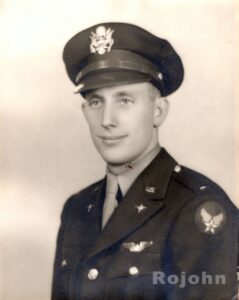
 Because my dad, Allen Spencer was the flight engineer and top turret gunner on a B-17G in World War II, the B-17 has always held my interest. The plane was practically indestructible because of its great flying characteristics, resistance to combat damage, and fierce defensive firepower. Built by Boeing, it was called the B-17 Flying Fortress and it was the backbone of the American bomber force in Europe. In the European Theater of World War II (1939-1945), “one of the most dangerous occupations for Allied soldiers, sailors, or airmen was the flying of strategic bombers.” That was a statement that surprised me a little, because I would have expected the men on the ground to be in far more danger. I knew that there was a time my dad had to hang out of the open bomb bay doors to crank the landing gear down when they were damaged in combat, and I vaguely recall that they lost a ball turret gunner when he was wounded in battle and, while they pulled him out to render aid, they couldn’t save him.
Because my dad, Allen Spencer was the flight engineer and top turret gunner on a B-17G in World War II, the B-17 has always held my interest. The plane was practically indestructible because of its great flying characteristics, resistance to combat damage, and fierce defensive firepower. Built by Boeing, it was called the B-17 Flying Fortress and it was the backbone of the American bomber force in Europe. In the European Theater of World War II (1939-1945), “one of the most dangerous occupations for Allied soldiers, sailors, or airmen was the flying of strategic bombers.” That was a statement that surprised me a little, because I would have expected the men on the ground to be in far more danger. I knew that there was a time my dad had to hang out of the open bomb bay doors to crank the landing gear down when they were damaged in combat, and I vaguely recall that they lost a ball turret gunner when he was wounded in battle and, while they pulled him out to render aid, they couldn’t save him.
What I didn’t know about was something that happened on January 1, 1945, that was so bizarre that it seems like a ‘tall tale’ more than an actual event. Nevertheless, it was an actual event, and it was shocking. On that day, the Flying Fortress and the men who flew them were going to be tested beyond any limits they could have imagined, and beyond anything they were trained for. During a chaotic battle complete with ferocious anti-aircraft gunfire (flak) and enemy fighters, two B-17 Bombers managed to collide. A B-17, number 43-338457, piloted by 1st Lieutenant William G MacNab and 2nd Lieutenant Nelson B Vaughn, had risen upward. The top turret guns on MacNab’s plane had pierced through the aluminum skin on the bottom of 1st Lieutenant Glenn H Rojohn’s B-17, number 42-231987, binding the two huge planes together, as Rojohn’s co-pilot 2nd Lieutenant William G Leek, Jr said, like ‘breeding dragonflies.’ The two planes had become one. Upon impact, instead of exploding or breaking into pieces, the colliding planes became stuck together in a piggyback fashion, one atop the other. I’m sure that the men in the top plane, at least were in shock at this strange turn of affairs. I say the top plane, because it is thought that the men in the bottom plane were incapacitated or dead. There was no communication with them. Once the men realized that they weren’t going to crash, they would have to figure out their next move.
Even more shocked than the crew of the B-17 were the German fighter pilots who suddenly saw the whole confusing, but disastrous event. People just don’t expect that a mid-air collision could result in two planes stuck together. For the German fighter pilots, however, the situation took on an even more bizarre tone, because they honestly thought that the US must have created some sort of new secret weapon!! For the men onboard, the situation was dire. I’m sure they expected the explosion to come at any moment, so some of the airmen bailed out. The pilot of the top bomber, Rojohn tried, but was unable to separate the aircraft. Strangely, he was able to control the flight of the ‘hybrid dual-bomber’ somehow, despite turning his own engines off. The lower plane’s engines were still running, because its propellers were still turning. There was no communication with the crew of the bottom plane, which is why it was assumed that they were either incapacitated or already dead.
In a valiant effort, Rojohn decided to try to land the planes, probably hoping that the other crew could be saved, and complicated by the fact that he and his co-pilot, Leek couldn’t get out anyway. At that point, he might as well do his best to save the two or more of them that he could. He coaxed the joined bombers to a relatively safe landing in Germany at Wilhemshaven. Unfortunately, the lower bomber slid out from under the top bomber upon landing and immediately exploded. While the crew of the lower bomber perished in the landing and subsequent explosion, most of the crew of Rojohn’s B-17 survived and was taken prisoner. While being held in the camps, the German interrogators, who were skeptical of the account of the incident given by 
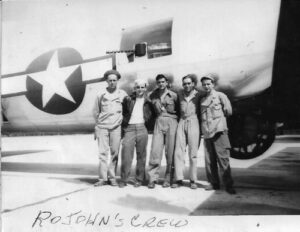 Rojohn, initially were of the opinion the flight represented a new American aerial design. I’m sure they later realized their error, but they must have also realized the resiliency of the B-17 Flying Fortress. Rojohn and his co-pilot, Leek, earned the Distinguished Flying Cross for their feat of aerial skill…a well-deserved award, if you ask me.
Rojohn, initially were of the opinion the flight represented a new American aerial design. I’m sure they later realized their error, but they must have also realized the resiliency of the B-17 Flying Fortress. Rojohn and his co-pilot, Leek, earned the Distinguished Flying Cross for their feat of aerial skill…a well-deserved award, if you ask me.

 There are a number of different kinds of governments, and people disagree on which is the best. Personally, I think that any government that takes away the freedoms of its people is destined to fail. Communism is a “political theory derived from Karl Marx, advocating class war and leading to a society in which all property is publicly owned, and each person works and is paid according to their abilities and needs.” Communism is also, known as Marxism, which is defined as “the political and economic theories of Karl Marx and Friedrich Engels, later developed by their followers to form the basis for the theory and practice of communism.” I don’t think most people know the real meaning of Marxism or Communism, or, for that matter, Socialism, which is “a political and economic theory of social organization which advocates that the means of production, distribution, and exchange should be owned or regulated by the community as a whole.” If people knew what these types of governments are really like, they would fight to keep them out of their countries. The problem is that people think the government will take care of them, and that they will benefit from the work of others. It never works that way. everyone in these situations gets poorer, except for the government.
There are a number of different kinds of governments, and people disagree on which is the best. Personally, I think that any government that takes away the freedoms of its people is destined to fail. Communism is a “political theory derived from Karl Marx, advocating class war and leading to a society in which all property is publicly owned, and each person works and is paid according to their abilities and needs.” Communism is also, known as Marxism, which is defined as “the political and economic theories of Karl Marx and Friedrich Engels, later developed by their followers to form the basis for the theory and practice of communism.” I don’t think most people know the real meaning of Marxism or Communism, or, for that matter, Socialism, which is “a political and economic theory of social organization which advocates that the means of production, distribution, and exchange should be owned or regulated by the community as a whole.” If people knew what these types of governments are really like, they would fight to keep them out of their countries. The problem is that people think the government will take care of them, and that they will benefit from the work of others. It never works that way. everyone in these situations gets poorer, except for the government.
The Union of Soviet Socialist Republics (USSR) was established in post-revolutionary Russia, on December 30, 1922. It combined Russia, Belorussia, Ukraine and the Transcaucasian Federation (which was divided in 1936 into the Georgian, Azerbaijan and Armenian republics). The new nation was also known as the Soviet Union. It was the successor to the Russian Empire and the first country in the world to be based on Marxist socialism. The rest of the world was rather stunned that this kind of regie actually existed, because it took away so many freedoms and personal property, and the people had no choice.
Because Russia was reeling from the Russian Revolution of 1917 and subsequent three-year Russian Civil War, the Bolshevik Party under Vladimir Lenin dominated the soviet forces. A coalition of workers’ and soldiers’ committees called for the establishment of a socialist state in the former Russian Empire. It was from there that the USSR was formed, and after that, all levels of government were controlled by the Communist Party, and the party’s Politburo, with its increasingly powerful general secretary, who effectively ruled the country. Everything, from Soviet industry was owned and managed by the state, and agricultural land was immediately confiscated and divided into state-run collective farms.
Over the coming decades, the Russian-dominated Soviet Union grew into one of the world’s most powerful and influential states. It eventually encompassed 15 republics…Russia, Ukraine, Georgia, Belorussia, Uzbekistan, Armenia, Azerbaijan, Kazakhstan, Kyrgyzstan, Moldova, Turkmenistan, Tajikistan, Latvia, Lithuania and Estonia. 
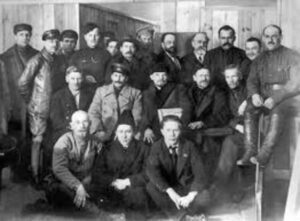 The USSR, as many knew it must, eventually failed because you can’t place people into a slave state without eventual rebellion. In 1991, the Soviet Union was dissolved following the collapse of its communist government. Communism, Marxism, and Socialism simply won’t work in the long run. If a nation wants growth and prosperity, they must have capitalism, so that the people have the incentive to be entrepreneurs, inventors, scientists, and so many other occupations in which discovery is made. Without incentive, people will simply quit.
The USSR, as many knew it must, eventually failed because you can’t place people into a slave state without eventual rebellion. In 1991, the Soviet Union was dissolved following the collapse of its communist government. Communism, Marxism, and Socialism simply won’t work in the long run. If a nation wants growth and prosperity, they must have capitalism, so that the people have the incentive to be entrepreneurs, inventors, scientists, and so many other occupations in which discovery is made. Without incentive, people will simply quit.
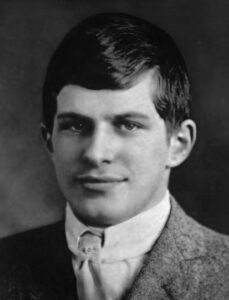
 They say that genius can be the closest thing to crazy, but I don’t really know how true that is. Sometimes I think that when a person is a genius, people drive them crazy. It’s the novelty of the thing, I suppose. People find out that the genius has a super high IQ, and they all seem to want something from them. Many people don’t really care about the genius as a person, just about how they might be able to make money off of them somehow. Not every inventor is a genius, but some of them are, as are some mathematicians, doctors, teachers, writers, and many other people too.
They say that genius can be the closest thing to crazy, but I don’t really know how true that is. Sometimes I think that when a person is a genius, people drive them crazy. It’s the novelty of the thing, I suppose. People find out that the genius has a super high IQ, and they all seem to want something from them. Many people don’t really care about the genius as a person, just about how they might be able to make money off of them somehow. Not every inventor is a genius, but some of them are, as are some mathematicians, doctors, teachers, writers, and many other people too.
Sometimes the demands placed on these geniuses gets to be so heavy, that they might just snap. I don’t mean that they might go insane, although some of them have. The thing that seems to happen most, however, is that they might just decide to disappear. Several geniuses have simply vanished,  including William Sidis (who graduated from Harvard at 16, only to go into hiding, going from city to city and job to job), JD Salinger (author of Catcher in the Rye, who left Manhattan in 1953 to live on a “90-acre compound” in Cornish, NH. He remained there until his death in 2010, at age 91, saying he loved to write, but publishing was a terrible invasion of his privacy), Ettore Majorana (a theoretical physicist was considered one of the most deeply brilliant men in the world by Enrico Fermi, creator of the first nuclear reactor. One day he drained his bank account and simply vanished), David Thorne (an architect received so much attention for his work on jazz giant Dave Brubeck’s house in 1954, that he changed his professional name in the ‘60s to Beverly Thorne, got an unlisted phone number, and didn’t “resurface” until the 1980s), and Nick Gill (who at 21, was the youngest-ever British chef to win a Michelin star. He seemed destined for a life of fame and fortune and was hailed as a culinary genius. One day he told his brother he was going to disappear, and to “please, not look for him,” never to be seen again).
including William Sidis (who graduated from Harvard at 16, only to go into hiding, going from city to city and job to job), JD Salinger (author of Catcher in the Rye, who left Manhattan in 1953 to live on a “90-acre compound” in Cornish, NH. He remained there until his death in 2010, at age 91, saying he loved to write, but publishing was a terrible invasion of his privacy), Ettore Majorana (a theoretical physicist was considered one of the most deeply brilliant men in the world by Enrico Fermi, creator of the first nuclear reactor. One day he drained his bank account and simply vanished), David Thorne (an architect received so much attention for his work on jazz giant Dave Brubeck’s house in 1954, that he changed his professional name in the ‘60s to Beverly Thorne, got an unlisted phone number, and didn’t “resurface” until the 1980s), and Nick Gill (who at 21, was the youngest-ever British chef to win a Michelin star. He seemed destined for a life of fame and fortune and was hailed as a culinary genius. One day he told his brother he was going to disappear, and to “please, not look for him,” never to be seen again).
It isn’t known, as to why these geniuses would decide that they no longer wanted to be a part of the world, nor 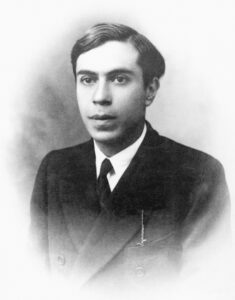
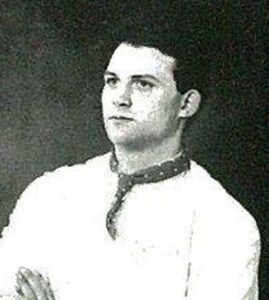 are they to only people to do this by any means. Nevertheless, they seem to have one thing in common, their genius skill or knowledge seemed to take over their whole life, and people wouldn’t leave them alone, but rather hounded them unmercifully. I think I can understand how that would be enough to make someone want to disappear, but most people don’t actually go so far as to take that step. It is a rather extreme step to take, and for all we know some of these might have been killed or committed suicide. The sad reality for these genius minds is that the fame and constant pressure of celebrity was too much for them, and they just checked out, because the burden of knowledge was just too much for them.
are they to only people to do this by any means. Nevertheless, they seem to have one thing in common, their genius skill or knowledge seemed to take over their whole life, and people wouldn’t leave them alone, but rather hounded them unmercifully. I think I can understand how that would be enough to make someone want to disappear, but most people don’t actually go so far as to take that step. It is a rather extreme step to take, and for all we know some of these might have been killed or committed suicide. The sad reality for these genius minds is that the fame and constant pressure of celebrity was too much for them, and they just checked out, because the burden of knowledge was just too much for them.
 For thousands of years, people have wanted to feel like they left a mark on this Earth…a way to say, “I was here.” Not everyone could be famous, and in fact most people aren’t famous, nor would they want to be. Still, they want to feel like their life mattered…like someone cared that they had lived. Many of us, in fact most people are not famous. They are just everyday people who go about their daily lives…working, raising families, going to school and church, and spending time with families. Their lives would not be thought of as spectacular. Still for most people, someone…somewhere cares that they existed. Nevertheless, in 100 years it’s quite likely that no one will even remember their name.
For thousands of years, people have wanted to feel like they left a mark on this Earth…a way to say, “I was here.” Not everyone could be famous, and in fact most people aren’t famous, nor would they want to be. Still, they want to feel like their life mattered…like someone cared that they had lived. Many of us, in fact most people are not famous. They are just everyday people who go about their daily lives…working, raising families, going to school and church, and spending time with families. Their lives would not be thought of as spectacular. Still for most people, someone…somewhere cares that they existed. Nevertheless, in 100 years it’s quite likely that no one will even remember their name.
These days that may be changing with sites like Ancestry.com, My Heritage, 23 and Me, and probably others, people find it easier to be “known” by the masses. Still, many people don’t even notice if a friend lands in Facebook Jail…until they get out and tell everyone. Really most of us just live our lives…day by day, expecting everything to be normal and no real excitement. With that in mind, some people found a new way to leave a  little piece of their lives in a safe place to be found by someone else, years later. In fact, it has become a big deal…called a “Time Capsule” but it isn’t new. There was a time capsule at the high school I graduated from, and its opening years later was documented by my niece, Liz Masterson, who graduated from there too, and now is a teacher there. There was also a time capsule in a local restaurant that was found when they did some remodeling many years later. Some time capsules are even older, such as the one found in 2015 in the Cairngorms National Park in Scotland. This one was a 121-year-old time capsule, and it was discovered by construction workers on a section of the Ruthven Road bridge.
little piece of their lives in a safe place to be found by someone else, years later. In fact, it has become a big deal…called a “Time Capsule” but it isn’t new. There was a time capsule at the high school I graduated from, and its opening years later was documented by my niece, Liz Masterson, who graduated from there too, and now is a teacher there. There was also a time capsule in a local restaurant that was found when they did some remodeling many years later. Some time capsules are even older, such as the one found in 2015 in the Cairngorms National Park in Scotland. This one was a 121-year-old time capsule, and it was discovered by construction workers on a section of the Ruthven Road bridge.
Time capsules can be any kind of container. They just need to be able to stand up to the environment they are placed in. A wooden box is ok in a place that won’t get wet, and most times people try to place things in such a place. The Cairngorms National Park capsule was a metal box, similar to a safe-deposit box at a bank. The excitement around the time capsule grew, and when it was opened, the items inside that were found included… a bottle of whisky, a newspaper from 1894, a scroll, and some other items. As often happens, the items and the box itself were donated to the nearby Highland Folk Museum to be studied. As to the timeframe, it is believed that the time capsule was placed within the structure of the bridge when it was originally constructed at the end of the 19th century, so the 1894 newspaper wasn’t far off. Of course, unless there were specific names in the box, the people in the particular show of “I was here” will remain a mystery. Still, they will be remembered, even if we don’t know exactly who “they” were.
a bottle of whisky, a newspaper from 1894, a scroll, and some other items. As often happens, the items and the box itself were donated to the nearby Highland Folk Museum to be studied. As to the timeframe, it is believed that the time capsule was placed within the structure of the bridge when it was originally constructed at the end of the 19th century, so the 1894 newspaper wasn’t far off. Of course, unless there were specific names in the box, the people in the particular show of “I was here” will remain a mystery. Still, they will be remembered, even if we don’t know exactly who “they” were.

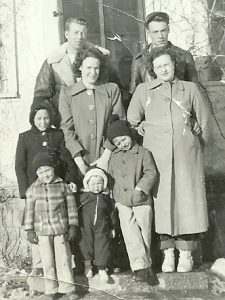 My husband’s aunt, Esther Hein, as a young girl living in the country near Forsyth, Montana, spent some of her school years living in a “boarding house” of sorts. It wasn’t really, but it may have seemed like it to her, except that the owners of the “boarding house” were her half-brother, Walt Schulenberg and sister-in-law, Joann Schulenberg. The problem Esther’s parents, Vina and Walt Hein, faced was that Esther needed to go to school on a regular basis, and the Montana winters had a way of creating a “snowed in” situation for the people who lived in the country. The people living in town could still get their kids to school, but the long country roads could not always be cleared, and when the snow was deep, they mostly couldn’t. So, they often didn’t try. That meant those kids living in the country didn’t get to school when the snow got deep, and as we all know, missing too much school means that the child isn’t going to pass.
My husband’s aunt, Esther Hein, as a young girl living in the country near Forsyth, Montana, spent some of her school years living in a “boarding house” of sorts. It wasn’t really, but it may have seemed like it to her, except that the owners of the “boarding house” were her half-brother, Walt Schulenberg and sister-in-law, Joann Schulenberg. The problem Esther’s parents, Vina and Walt Hein, faced was that Esther needed to go to school on a regular basis, and the Montana winters had a way of creating a “snowed in” situation for the people who lived in the country. The people living in town could still get their kids to school, but the long country roads could not always be cleared, and when the snow was deep, they mostly couldn’t. So, they often didn’t try. That meant those kids living in the country didn’t get to school when the snow got deep, and as we all know, missing too much school means that the child isn’t going to pass.
So, in what is really one of the sweetest and funniest stories about Aunt Esther that I know, Esther moved in with her brother and sister-in-law. Things usually went smoothly, but you must understand that Esther was a child, with child-like ways at the time. There were times that she didn’t get along with her brother, sister-in-law, and cousins. It was nothing major, just kid stuff and maybe a little sassiness. My future mother-in-law, and Esther’s sister-in-law, Joann sometimes got tired and annoyed. She might have been able to spank her sister-in-law, but she might not have felt comfortable doing that either. That said, when she was annoyed with Esther, her common comment was “Don’t Esther!!” This might seem like it isn’t very funny, but later in life, my mother-in-law had Alzheimer’s Disease…which isn’t exactly funny either.
Nevertheless, my mother-in-law had her “funny” Alzheimer’s moments, as they all do, if you look beyond the disease. She didn’t always like things like going to bed, taking a walk around the house, or especially telling her to stop scratching her itchy skin. Since I was her caregiver quite often, I was the “bad guy” that made her do 
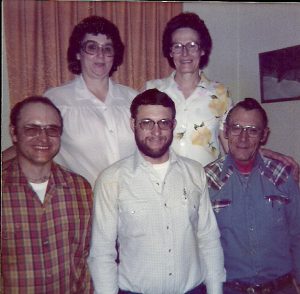 these things. Her very itchy skin, and the fact that she scratched too hard, caused injury to her skin, so I had to stop her from scratching. Whenever I try to stop her, she would say, “Don’t Esther!!” The first time she said that I was shocked, but once I heard the “Don’t Esther” story, I finally understood that she was mistaking me for Esther in those moments. For me it was liberating. That meant that sometimes when my mother-in-law was mad at me, I could let Esther take the blame. Sorry Esther, but it worked for me. Today is Esther’s 82nd birthday. Happy birthday Esther!! Have a great day!! We love you!!
these things. Her very itchy skin, and the fact that she scratched too hard, caused injury to her skin, so I had to stop her from scratching. Whenever I try to stop her, she would say, “Don’t Esther!!” The first time she said that I was shocked, but once I heard the “Don’t Esther” story, I finally understood that she was mistaking me for Esther in those moments. For me it was liberating. That meant that sometimes when my mother-in-law was mad at me, I could let Esther take the blame. Sorry Esther, but it worked for me. Today is Esther’s 82nd birthday. Happy birthday Esther!! Have a great day!! We love you!!

 Just outside the little village of Chatillon in Southern Belgium, on top of a tree covered hill, hidden from view, there was a “car cemetery” filled with cars that once belonged to the US servicemen stationed there. No one really knows how the soldiers came to obtain the cars exactly, especially since they were mostly American made cars…meaning they must have been shipped over to Belgium. So, the soldiers who were stationed in Belgium during World War II somehow had cars to drive to get around while they were serving over there.
Just outside the little village of Chatillon in Southern Belgium, on top of a tree covered hill, hidden from view, there was a “car cemetery” filled with cars that once belonged to the US servicemen stationed there. No one really knows how the soldiers came to obtain the cars exactly, especially since they were mostly American made cars…meaning they must have been shipped over to Belgium. So, the soldiers who were stationed in Belgium during World War II somehow had cars to drive to get around while they were serving over there.
Then, once the war was over, the soldiers returned to the United States. I suppose that bringing the vehicles over happened a few at a time, but shipping them back would be a massive undertaking, so it was decided to leave them behind. To me, it would seem like they should have given the cars away. At least that way, people in the area could have a car, when they might not have been able to afford one any other way. Nevertheless, that was not how it was done. The officers in charge decided to leave them in the country and parked them all up at the top of a hill, which was hidden from view. It was left up to the individual soldier whether or not they wanted to have their car shipped to them once they returned home, at their own expense. Not one of them decided to retrieve their car. These days the way things took place in the end, would have very likely cause an international uproar because they basically littered the landscape with junk cars. Of course, they weren’t junk at the time, and I suppose the people of the area could have taken the cars as abandoned. I’m not sure how they would have run when it was finally determined that they were abandoned, and maybe it was decided that it would cost too much. That may be the reason that none of the soldiers ever claimed their vehicles…a cost too heavy and no help in sight.
After many years, the forest was in the process of making very slow work of returning the cars to nature. The stories about the “Car Cemetery” persisted, and possibly complaints too. It was said that American-made cars had been brought by American and Canadian NATO troops to a mechanic in Châtillon. One by one, the cars were driven up a hill, parked, and somehow hidden from the outside world. Eventually, local people added their own old cars too. Possibly the mechanic was to keep them for the soldiers, but after France’s 1966 withdrawal from NATO, he was left “holding the bag” as it were, with hundreds of scrap cars that gradually became overgrown until a television documentary brought the “illegal dump” to light. Finally, the cars were removed and crushed in October 2010.
To date, some of the cars are said to still be there. At one point there was not one but four car graveyards 
 around the village of Chatillon with as many as 500 vehicles. The ones that remain today are only a fraction of the original number of cars. A lot of cars and their parts were stolen by the locals and international car collectors, so maybe some of them have been restored before they were completely lost. Either way, it was a very strange situation.
around the village of Chatillon with as many as 500 vehicles. The ones that remain today are only a fraction of the original number of cars. A lot of cars and their parts were stolen by the locals and international car collectors, so maybe some of them have been restored before they were completely lost. Either way, it was a very strange situation.


 Looking back on my life really, but focusing on Christmases, so much has changed. I remember Christmases with my parents and my sisters…simple times with just our family. After we opened gifts in the morning, the house would begin to be filled with the wonderful smells of the coming dinner. While things were cooking, we were playing with our various toys and such. While the day was relaxed and fun for my sisters and me, I’m sure it wasn’t quite as relaxed for my parents, who would spend most of the day with meal preparations. Nevertheless, they lovingly prepared for that dinner, and before very long, dinner was ready…and what a dinner it was. My parents could really cook. I can still taste all those wonderful foods.
Looking back on my life really, but focusing on Christmases, so much has changed. I remember Christmases with my parents and my sisters…simple times with just our family. After we opened gifts in the morning, the house would begin to be filled with the wonderful smells of the coming dinner. While things were cooking, we were playing with our various toys and such. While the day was relaxed and fun for my sisters and me, I’m sure it wasn’t quite as relaxed for my parents, who would spend most of the day with meal preparations. Nevertheless, they lovingly prepared for that dinner, and before very long, dinner was ready…and what a dinner it was. My parents could really cook. I can still taste all those wonderful foods.
Later, with the marriages of my sisters and me, the dinners became a little more complicated, meaning we would need to incorporate the in-laws’ side of the family. Still, it worked out, with a little bit of time management. We somehow managed to go both places and eat two meals…were we ever full sometimes!! With 
 so many good foods, it’s hard to take a small sampling of them, and walk away from the rest. The day usually ended with us feeling like beached whales as we crashed on the couch or the floor. Nevertheless, the kids enjoyed the day, and really, wasn’t that what it was all about, after all. As the next generation grew to marriage age, we had to try to combine again…this time adding the new set of in-laws to the mix. That usually meant dinner at the grandparents’ homes with multiple generations all crowded into the house. Still, togetherness was the key to it all. Now, it was the great grandchildren we focused on, because they were the new little ones, and the excitement centered around them.
so many good foods, it’s hard to take a small sampling of them, and walk away from the rest. The day usually ended with us feeling like beached whales as we crashed on the couch or the floor. Nevertheless, the kids enjoyed the day, and really, wasn’t that what it was all about, after all. As the next generation grew to marriage age, we had to try to combine again…this time adding the new set of in-laws to the mix. That usually meant dinner at the grandparents’ homes with multiple generations all crowded into the house. Still, togetherness was the key to it all. Now, it was the great grandchildren we focused on, because they were the new little ones, and the excitement centered around them.
The next change that happened was when our parents went home to Heaven. That was probably the biggest change of all…and the hardest to accept. Now we have a big family Christmas party a week or so before Christmas or on Christmas Eve, and Christmas Day we go our separate ways to celebrate with our own families. We are the great grandparents or grandparents now, and it’s our children who have to work around the in-laws in their own way. Some trade years, others go both places, and others celebrate on two different days to make it easier on everyone. Who could have known all those years ago, when this all got started, that Christmas could be so complicated.

 With all the complicated holiday situations, it is important to remember the real reason for the season…the birth of our Lord and Savior, Jesus Christ. While God is all for giving gifts, He always hopes that we will remember the greatest gift ever given…Jesus!! Were it not for Jesus, we would be doomed. So, while the gifts are nice, and the food is great, let’s not forget why we celebrate this day…the birth of our Savior. Happy birthday Jesus!! Thank you coming to Earth and saving the world!!
With all the complicated holiday situations, it is important to remember the real reason for the season…the birth of our Lord and Savior, Jesus Christ. While God is all for giving gifts, He always hopes that we will remember the greatest gift ever given…Jesus!! Were it not for Jesus, we would be doomed. So, while the gifts are nice, and the food is great, let’s not forget why we celebrate this day…the birth of our Savior. Happy birthday Jesus!! Thank you coming to Earth and saving the world!!
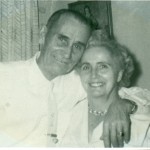
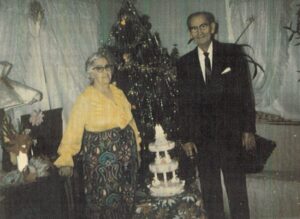 Christmas Eve…the half day beginning of the Christmas holiday. I say, half day, because many businesses are open half of the day, letting their employees off early to spend time with their families. For some families the opening of gifts is even done on Christmas Eve, while others are preparing for the festivities that will be taking place the next day. For my grandparents, as well as many other people across the world and even in my own family, Christmas Eve seems like the perfect day to be married. In my grandparents’ day, that was often how it happened, because family was gathered and gathering wasn’t always easy, so I suppose it was like “killing two birds, with one stone” for lack of a better analogy.
Christmas Eve…the half day beginning of the Christmas holiday. I say, half day, because many businesses are open half of the day, letting their employees off early to spend time with their families. For some families the opening of gifts is even done on Christmas Eve, while others are preparing for the festivities that will be taking place the next day. For my grandparents, as well as many other people across the world and even in my own family, Christmas Eve seems like the perfect day to be married. In my grandparents’ day, that was often how it happened, because family was gathered and gathering wasn’t always easy, so I suppose it was like “killing two birds, with one stone” for lack of a better analogy.
For my grandparents, George and Hattie Byer, it made the season that much more special. We all knew when they got married. From their kids on down to the great great grandkids, we knew, because it was a story that was passed down to every generation and an event that was celebrated every Christmas eve. It was something that made Christmas extra special. Just knowing that the whole family got started on Christmas eve was so very cool, and I think that for many years, we thought we were the only family to have such a special Christmas eve. We weren’t, of course, and in fact, every year other people get married on Christmas eve. Many people think it’s a great day for a wedding, and for those forgetful husbands, a difficult date to forget.

 For the rest of the world, Christmas eve is a day to prepare for the morning, attend Christmas eve services, and set out the cookies and milk. Then it’s a matter of trying to get the excited children to go to bed, because they will want to be up by 6:00am…if not earlier!! Before we know it, Christmas will be over, except for the opportunity to reflect on the real reason for the season…our Lord and Savior…Jesus Christ!! Merry Christmas Eve, and happy anniversary in Heaven to my grandparents. Have a wonderful day all!!
For the rest of the world, Christmas eve is a day to prepare for the morning, attend Christmas eve services, and set out the cookies and milk. Then it’s a matter of trying to get the excited children to go to bed, because they will want to be up by 6:00am…if not earlier!! Before we know it, Christmas will be over, except for the opportunity to reflect on the real reason for the season…our Lord and Savior…Jesus Christ!! Merry Christmas Eve, and happy anniversary in Heaven to my grandparents. Have a wonderful day all!!

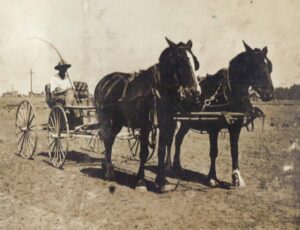 Road rage is a common expression these days. In fact, you would have to be living under a rock not to know what road rage is. Most of us think that road rage is something that has come about as there are more and more vehicles on the road; as well as the fact that so many people are so busy, and stress is an ever-present part of life. While I personally believe that road rage has really gotten out of hand, I suppose that it has actually taken centuries…yes, centuries to get there, but it really has gotten way out of control.
Road rage is a common expression these days. In fact, you would have to be living under a rock not to know what road rage is. Most of us think that road rage is something that has come about as there are more and more vehicles on the road; as well as the fact that so many people are so busy, and stress is an ever-present part of life. While I personally believe that road rage has really gotten out of hand, I suppose that it has actually taken centuries…yes, centuries to get there, but it really has gotten way out of control.
In fact, road rage didn’t even begin with the invention of the automobile. There are instances of “road rage” even as far back as the days of horses and chariots, as well as occurrences during the horse and buggy days, not to mention the days of bicycles. It seems that people have always argued over the right-of-way. The reality is that people have always argued over rights in general. For some people, when they get in the driver’s seat, many people check all sense of calmness at the entrance to the vehicle. These same people can’t seem to control their tempers and look beyond the mistake the other driver might have made, to notice that the offending driver might have been having a bad day.
Don’t get me wrong, I have been guilty of road rage too, and looking back I am pretty ashamed of myself for it. I have also been “guilty” of anti-road rage too, and I always walk away feeling awful. I far prefer to see the smile on the face of the offending person, who’s heart has been racing in anticipation of the screaming rage that is coming their way…the screaming rage that doesn’t come. Then, when they see the smile on my face telling them that all is well, and they aren’t going to get yelled at, their face floods with relief. I’m telling you, there is no better feeling behind the wheel than that.
In the instance I am referring to, I was at a traffic light waiting for my turn to go. The light changed to green, 
 and I prepared to go, when a car ran the red light. As she started into the intersection, her eyes were a big as saucers. It was my chance to change the situation. I smiled and waved her through the light. Shocked, she smiled back, and I can tell you that we both went to work that day feeling a lot better than we had just moments before. If only everybody just took a breath and smiled, instead of raging.
and I prepared to go, when a car ran the red light. As she started into the intersection, her eyes were a big as saucers. It was my chance to change the situation. I smiled and waved her through the light. Shocked, she smiled back, and I can tell you that we both went to work that day feeling a lot better than we had just moments before. If only everybody just took a breath and smiled, instead of raging.

 Lots of mining towns started out when someone discovered gold, silver, or some other precious metal. A few of them have continued to produce enough “treasure” to maintain and even rapidly grow a town. Others fizzled in a short time, or even a long time, but when the mines dried up, the towns went with them. Because of that, there are numerous ghost towns that dot the United States…and probably other nations too.
Lots of mining towns started out when someone discovered gold, silver, or some other precious metal. A few of them have continued to produce enough “treasure” to maintain and even rapidly grow a town. Others fizzled in a short time, or even a long time, but when the mines dried up, the towns went with them. Because of that, there are numerous ghost towns that dot the United States…and probably other nations too.
Ruby, Arizona is a ghost town in very near the Arizona-Mexico border. It is one of the best-preserved ghost towns in the state. In the 1700s, rich minerals were discovered there by the Spaniards, but they were not rich enough for their tastes, so only a limited amount of placer mining occurred before they moved on, leaving the area largely undisturbed for nearly a century, until two mining engineers, Chares Poston and Henry Ehrenberg, 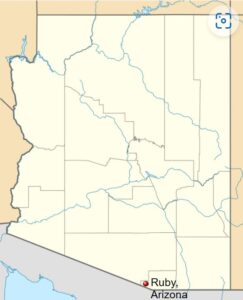 revived the old Spanish placers in Montana Gulch in 1854. With the discovery of rich veins of gold and silver, which the Spaniards had somehow missed, came other prospectors looking for their own rich strike. While the area was rich in gold and silver, it also had Apache Indians, and they were…hostile, to say the least.
revived the old Spanish placers in Montana Gulch in 1854. With the discovery of rich veins of gold and silver, which the Spaniards had somehow missed, came other prospectors looking for their own rich strike. While the area was rich in gold and silver, it also had Apache Indians, and they were…hostile, to say the least.
Nevertheless, mining did proceed starting around 1877. Ruby, Arizona was founded as a mining town in Bear Valley, originally named Montana Camp. It was so named because the miners were mining at the foot of Montana Peak. The Montana mine produced gold, silver, lead, zinc, and copper…peaking in the mid-1930s. While never a large town, Ruby had a population of about 1,200 people. The post office was established on April 11, 1912, by the mining camp’s general store, Julius Andrews. When Andrews named the post office “Ruby,” after his wife, Lille B Ruby Andrews, and the mining camp became known as Ruby. The post office closed on May 31, 1941.
The town of Ruby has been through some wild times, and never was that more evident than the years between 1920 and 1922, when the town and the area surrounding Ruby was the scene of three double homicides known as the Ruby Murders. The largest manhunt in the history of the Southwest followed the crimes, and it included the first airplane ever used in an Arizona manhunt. The town’s most prosperous period was in the late 1920s 
 and 1930s, when the Eagle-Picher Mining Company operated the mine. They also upgraded the camp. The Montana mine was the leading lead and zinc producer in Arizona from 1934 to 1937. In 1936, it was third in silver production. Nevertheless, it seems, in mining anyway, that “all good things must come to an end” and so it was with the mine, which closed in 1940. By the end of 1941 Ruby was abandoned.
and 1930s, when the Eagle-Picher Mining Company operated the mine. They also upgraded the camp. The Montana mine was the leading lead and zinc producer in Arizona from 1934 to 1937. In 1936, it was third in silver production. Nevertheless, it seems, in mining anyway, that “all good things must come to an end” and so it was with the mine, which closed in 1940. By the end of 1941 Ruby was abandoned.

